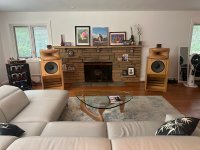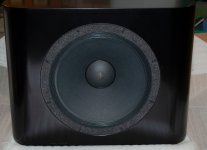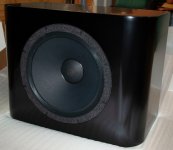While I am likely misinterpreting things here, does the 425 have any such propensity for this frequency "climbing"; and might it be characteristic of most JMLC horns, as opposed to the 4001, A290 and presumably Troy's ES290 and Docali's mk3b2? OTOH, might electrostats and many high performance headphones also present the frequency range of musical signals this way?Soundstage
Commenting briefly on the TH4001 horn, I appreciate how it positions the drivers closer together than the round AH425, and as a result, how musical instruments sound better integrated, e.g. notes don't appear to climb up or down in space according to their frequency..........
I think the issue of 'climbing' is often overrated.
The concept of 'integration' is often conflated with what 'looks' to be close. Integration can take place for more widely spaced bands.
Meanwhile, waveguides are being compromised to meet these goals. This is not what I consider to be a balanced approach, and that can compromise the chances of success.
The concept of 'integration' is often conflated with what 'looks' to be close. Integration can take place for more widely spaced bands.
Meanwhile, waveguides are being compromised to meet these goals. This is not what I consider to be a balanced approach, and that can compromise the chances of success.
But when I revisited this concern with Weltersys, and he then suggested that I simply place the AH425 horn only X inches from the midwoofer surrounds, there's no downside of doing this, yes?Meanwhile, waveguides are being compromised to meet these goals. This is not what I consider to be a balanced approach, and that can compromise the chances of success.
Post 15689 https://www.diyaudio.com/community/threads/beyond-the-ariel.100392/page-785#post-7978247
I guess it somewhat depends on where you cross. Woofer sound will diffract around the horn body, and yet some people have done it and report no problems.
I didn't suggest the placement of the AH425 horn "only X inches from the midwoofer surrounds".But when I revisited this concern with Weltersys, and he then suggested that I simply place the AH425 horn only X inches from the midwoofer surrounds, there's no downside of doing this, yes?
I wrote one could position the AH425 to overlap the woofer cabinet, reducing the "climbing distance" to less than that of the TH4001.
That said, the center to center "climbing distance" difference of 3.75" (the distance across the palm of my hand) between the two different horns and woofer doesn't amount to a hill of beans, or more technically even 1/4 wavelength below 875Hz.
Art
Last edited:
Was afraid of that.Woofer sound will diffract around the horn body.....
That's reassuring, and Troy can certainly adjust the height to ~ 3.75" to avoid both audible climbing frequency and diffraction occurrences.I didn't suggest the placement of the AH425 horn "only X inches from the midwoofer surrounds".
I wrote one could position the AH425 to overlap the woofer cabinet, reducing the "climbing distance" to less than that of the TH4001.
That said, the center to center "climbing distance" difference of 3.75" (the distance across the palm of my hand) between the two different horns and woofer doesn't amount to a hill of beans, or more technically even 1/4 wavelength below 875Hz.
Okay, then (honestly now), as it happens, Pierre just sold his 425 horns, and I'd expect that when in use he always had them mounted in these frames. https://www.diyaudio.com/community/threads/jmlc-horns-and-pedestals.422415/That said, the center to center "climbing distance" difference of 3.75" (the distance across the palm of my hand) between the two different horns and woofer doesn't amount to a hill of beans, or more technically even 1/4 wavelength below 875Hz.
Do the horns look high enough above his TAD 1601B woofers to cause noticeable "frequency climbing"?
"Two sets of holes on the vertical (frame) posts allow positioning the horn lower or higher according to taste."Do the horns look high enough above his TAD 1601B woofers to cause noticeable "frequency climbing"?
It appears the lower frame holes put the bottom of the AH425 horn above the cabinet by about 1.25 inches, the upper about 1 inch higher.
That's less distance than the difference in the height between the AH425 and the TH4001, which I already said doesn't amount to a hill of beans, which means something is insignificant, worthless, or of little importance.
If the resultant vertical shift in position with frequency of a few inches is something that bothers you, you might consider co-axial drivers or multiple entrant horns, which eliminate that feature inherent in any horn with a vertical dimension adequate to have control of frequencies in the 600-1000Hz range.
That said, if you didn't notice "frequency climbing" in the ES450 three-way system you listened to, you shouldn't be concerned about it.
Art
At that listening session, Glen had directed me to the far right side of the sofa as the ideal listening location, which was where he sits when listening alone, and where I sat for at least some of the session, though I may have shifted left towards the middle of that sofa. I’m 65” tall minus shoes. The trouble is I didn't actually document whether my ears were on axis with the center of the horn. But I don't think they were because throughout the session I do recall that I could barely, if at all, see the tweeter atop the horn.That said, if you didn't notice "frequency climbing" in the ES450 three-way system you listened to, you shouldn't be concerned about it.
Therefore, would it be surprising if I didn't hear frequency "climbing" under those conditions?
Attachments
Last edited:
The toe-in of Glen's speakers was focused somewhere behind the couch in your attached photo.The trouble is I didn't actually document whether my ears were on axis with the center of the horn. But I don't think they were because throughout the session I do recall that I could barely, if at all, see the tweeter atop the horn.
Therefore, would it be surprising if I didn't hear frequency "climbing" under those conditions?
If you couldn't see the both the tweeters and both mid horn throats, you weren't hearing their direct sound.
I wouldn't notice vertical frequency shifting, climbing or descending under those conditions, wouldn't be surprised if you didn't. Apparent location of indirect sounds can be ambiguous.
Most instruments and voices have harmonics covering several octaves.
It's unusual to find a source so devoid of harmonics through the speaker's acoustic crossover region that it's vertical placement would appear to drift between woofer and tweeter unless seated within a few feet of a system with more than a few feet of driver vertical center to center distance.
I asked Glen last night about this and replied as follows:The toe-in of Glen's speakers was focused somewhere behind the couch in your attached photo.
If you couldn't see the both the tweeters and both mid horn throats, you weren't hearing their direct sound.
I wouldn't notice vertical frequency shifting, climbing or descending under those conditions, wouldn't be surprised if you didn't. Apparent location of indirect sounds can be ambiguous.
I’m 69in tall so maybe a couple of inches up from where you were sitting. The horns are angled downward slightly on the base using different sized rubber balls in the front and rear of the horns such that for my ears they are vertically on axis within about an inch. Horizontally from where I sit, the horns are aligned about 1.5 feet outside of each ear. At some point I had them directly on axis with my ears too. There were advantages each way, but ultimately I preferred the larger soundstage with them towed out just slightly from my ears.
Measuring from my ear to the inner part of the horn is 3.3m /10.8 ft. It’s 3.0m/ 9.8 ft from my ear to the closest edge of the horn.
Glen's listening distance relative to center to center speaker distance and toe-in preferences are different from mine, and many others using similar systems to his.There were advantages each way, but ultimately I preferred the larger soundstage with them towed out just slightly from my ears.
Measuring from my ear to the inner part of the horn is 3.3m /10.8 ft. It’s 3.0m/ 9.8 ft from my ear to the closest edge of the horn.
Of course, many might prefer the way Glen currently sets his system to the way I would if it were mine.
That's what's great about DIY, you can design and adjust according to your own preferences as they evolve.
Art
- Home
- Loudspeakers
- Multi-Way
- JMLC and Yuichi horns measurements


